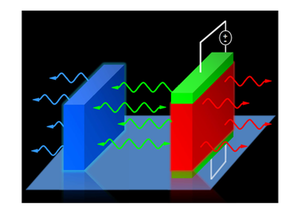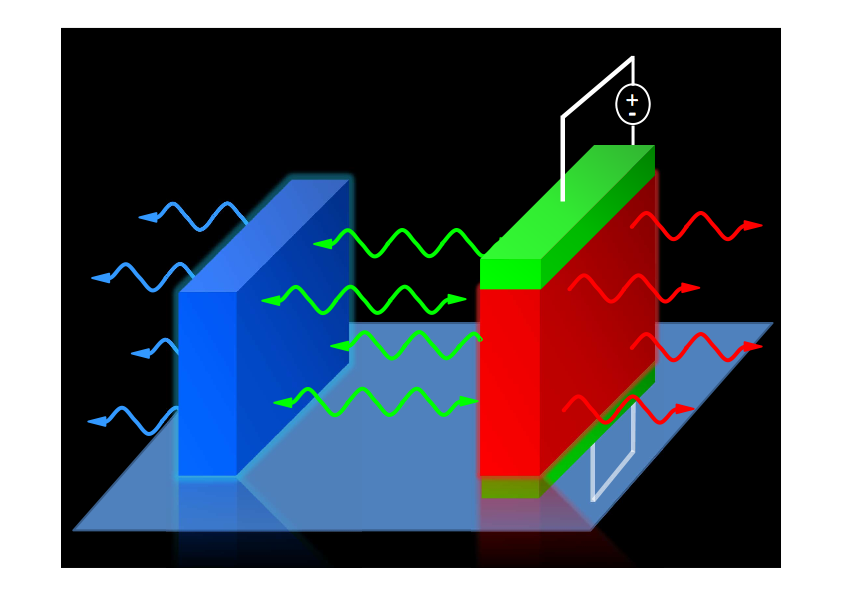Fast Bit-Switching in a Thermal Memory
Today’s information technology relies on electric currents, but researchers would like to produce digital circuits based instead on the flow of heat, at least for specialized purposes. In Physical Review Letters, a team brings that technology one step closer by describing a fast thermal memory—a component able to store a one or zero in a stable pattern of temperature. The proposed memory consists of two plates able to exchange heat through radiation, and it’s faster than previously proposed memories that rely on heat conduction.
For a decade theorists have been developing the concepts for thermal computing, not because they think it will be faster than conventional digital electronics, but because they think it could find some specialized uses. For example, thermal computing might allow sophisticated management of the heat flow in a computer chip, manipulating heat at the nanoscale.
The key building blocks of digital electronic circuits are memory elements, used to store information as zeros and ones, and transistors, used to switch electric currents on and off. Transistors are essential for the logic gates that process information. A technology for thermal information processing requires analogous elements for switching heat flows on and off and for storing bits as temperature differences.
Researchers have already created both switches and memory elements using materials such as semiconductors and carbon nanotubes, although the resulting technology is slow, limited by the speed at which heat flows by conduction through solid materials. In principle, says Philippe Ben-Abdallah of the University of Paris-Sud, faster devices might instead work with heat carried by electromagnetic radiation, which travels at the speed of light.
In January, Ben-Abdallah and Svend-Age Biehs of Carl von Ossietzky University in Oldenburg, Germany, showed how to make a fast switching transistor using this radiative approach [1]. Now, working with University of Paris colleague Viacheslav Kubytskyi, the three have described a radiative thermal memory. “A thermal memory is the last basic building block for making thermal circuits for photons,” says Ben-Abdallah.
Their scheme envisions two tiny and thin solid wafers held a few centimeters apart. Place these wafers between two bodies held at different fixed temperatures, and the wafers will exchange energy by radiation with each other and with the two bodies. Soon the wafers will settle into an equilibrium at two different temperatures, and .
The key to making a memory, the authors argue, is to make one of the wafers from an ordinary material such as glass and the other from something more exotic. They propose using vanadium dioxide (VO ), a material that changes its nature drastically at (K). Above this temperature, it conducts electricity easily, like a metal, while at lower temperatures it hardly conducts at all. The two states also have different thermal properties.
Because of this sharp change in properties, the wafers won’t have just one pair of equilibrium temperatures, but two, with the final state depending on the initial temperatures, the team shows mathematically. For example, assuming one specific setup, if the glass wafer starts out below , and the VO wafer starts out above , then the temperatures will end up at and , which the team calls state “one.” But for some other starting conditions, the temperatures end up at state “zero,” and . With two equilibrium states, the system is called “bistable.”
The team’s analysis shows that the state of such a memory could easily be switched between zero and one simply by heating or cooling the VO wafer by about two degrees, to push it across its phase transition. In principle, says Ben-Abdallah, the change might be induced in as little as a nanosecond, a bit slower than today’s electronic memories. Reading the bit value could be done by measuring the conductivity of the VO . Of course, the ultimate thermal-radiation-based digital circuits would use photons for reading and controlling (“writing”) the bit value, but the researchers are only describing the operation of the memory for now.
Ben-Abdallah and colleagues are now working to demonstrate the device in practice. That shouldn’t be too difficult, says Baowen Li of the National University of Singapore. “This device will be very useful in using and managing waste heat energy and controlling heat flow at the microscopic level,” he says.
–Mark Buchanan
Mark Buchanan is a freelance science writer who splits his time between Abergavenny, UK, and Notre Dame de Courson, France.
References
- Philippe Ben-Abdallah and Svend-Age Biehs, “Near-Field Thermal Transistor,” Phys. Rev. Lett. 112, 044301 (2014)





